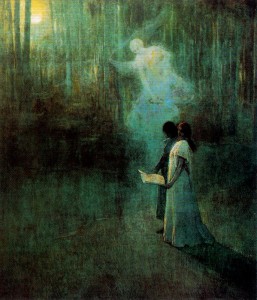
Canto de amor (source)
In the example of monological combat I posted, I was not quite sure how to handle saving throws versus magic. The traditional approach (of the referee rolling saving throws for each monster) seems to break the design. Though I do not think that having a universal core mechanic is always desirable, I would still like to see if I can get magic to fit within this framework more naturally.
A first sketch of how this might look. Player rolls 1d20, and adds some bonus reflective of magic skill or spell power. This number is then compared to some sort of magic defense target number for each potential target. One simple instantiation of this structure would be 1d20 + magic-user level versus 10 + enemy combat rating. That is, the magic target number would be the same as the combat target rating. Given that many spells have non-damage effects, this would not entirely homogenize action types from different classes (something that I would like to avoid), though for damage dealing spells it does have that effect to some degree.
For example, a monster of level 5 has a target number of 10 (base) + 5 (level) = 15. Hitting it with a sword thus requires rolling 1d20 + combat bonus and achieving 15 or higher. Affecting it with a fireball (say) would also require rolling 1d20 + magic bonus (whatever that is) and achieving 15 or higher (with full damage being inflicted on success and half damage on failure). That seems usable, and has the added benefit of allowing compatibility with most published monsters that have traditional stats (just let level = HD, making the general target number 10 + HD). Exactly what the magic bonus is would probably depend on exactly what base system I was bolting this onto, but in addition to magic-user level, one could also use the max level of spell that could be cast (which is usually approximately class level divided by two).
The downside is that the differentiation between defense modes is minimal. The main difference is that armor (as damage reduction) would not come into play most of the time for resisting spells. Another thought I had is that monsters could be divided between supernatural and mundane, with only supernatural monsters adding their level to the magic defense target number. In this case, a bear, despite having a level of around 4 when considering physical combat, would have a magic target number of only 10, whereas something like a wraith would add level. This would make some monsters more susceptible to magic than others, which could lead to some interesting tactics. There is maybe space for a midpoint quasi-magic type of creature as well (that would add half level to the target number, or something along those lines). I am not sure if this would be too fiddly in practice, but it seems reasonable on paper here. Defaulting to 10 + level is probably easier though.
What about the equivalent of PCs making saves versus enemy spells? That is handled the same way, just with failure meaning the PC is affected and success meaning the effect is avoided (or mitigated). Sorcerous classes should probably add some bonus to this roll, while other classes would be more vulnerable to the effects of spells. Ability score modifiers could also be brought into play if desired without dramatically affecting the system.
See also:

So the mage throws a fireball that might hit 3 foes, does he roll once or 3 times?
The way your monster save theory is going it sounds as though monsters would have tags (like supernatural, lurker etc) that would affect their saves. This could also apply to Priest magic like Turn spells/abilities, undead being susceptible to the Turn spell.
I would have thought mages would have magic protection from spells (aka damage reduction armour for the fighter) so if they failed save they take damage – lvl or lvl/2 or some other formula.
@Mark
For the sake of simplicity, I would advocate rolling once and comparing the result to each potential target. It is true that this narrows the range of potential outcomes and makes the effects of spells more binary, but I think that shortcoming is probably worth the increase in playability. This system wouldn’t break by any means if you rolled once per target (D&D 4 does that, I think), but it would make the resolution a bit more cumbersome.
I like the idea of damage reduction versus magic. Currently, I am handing magic defense using spell shields as described here:
http://www.necropraxis.com/2013/10/19/magical-defense/
This is a bit more general, given that many offensive spells do not deal damage (sleep, charm, etc), and also remains within the magic-user resource paradigm.
Magic damage reduction seems like it might be natural as a property of robes or other sorcerous vestments. Perhaps just sub that instead of the save bonus I gave to wizard robes here:
http://www.necropraxis.com/2012/10/17/wizard-robes/
Thanks for taking the time to read and comment. I know these monologic game design posts can be a bit dense and dry.
4E made several rolls but only one damage roll. At least that is what I remember. I prefer a single roll as it is slightly faster.
I was thinking that magic damage reduction was inherent in the class rather than their robes. If priests have magic reduction then they should probably be cloth wearers only.
Thieves could have damage reduction from ranged attacks due to their superior dodge.
The posts are interesting game design, but the differences to B/X make it harder to comment.
You might be surprised how similarly it plays to B/X in practice. In some ways, it just collapses some of the I go/you go into a single roll and adds some weight to being able to select the engagement.